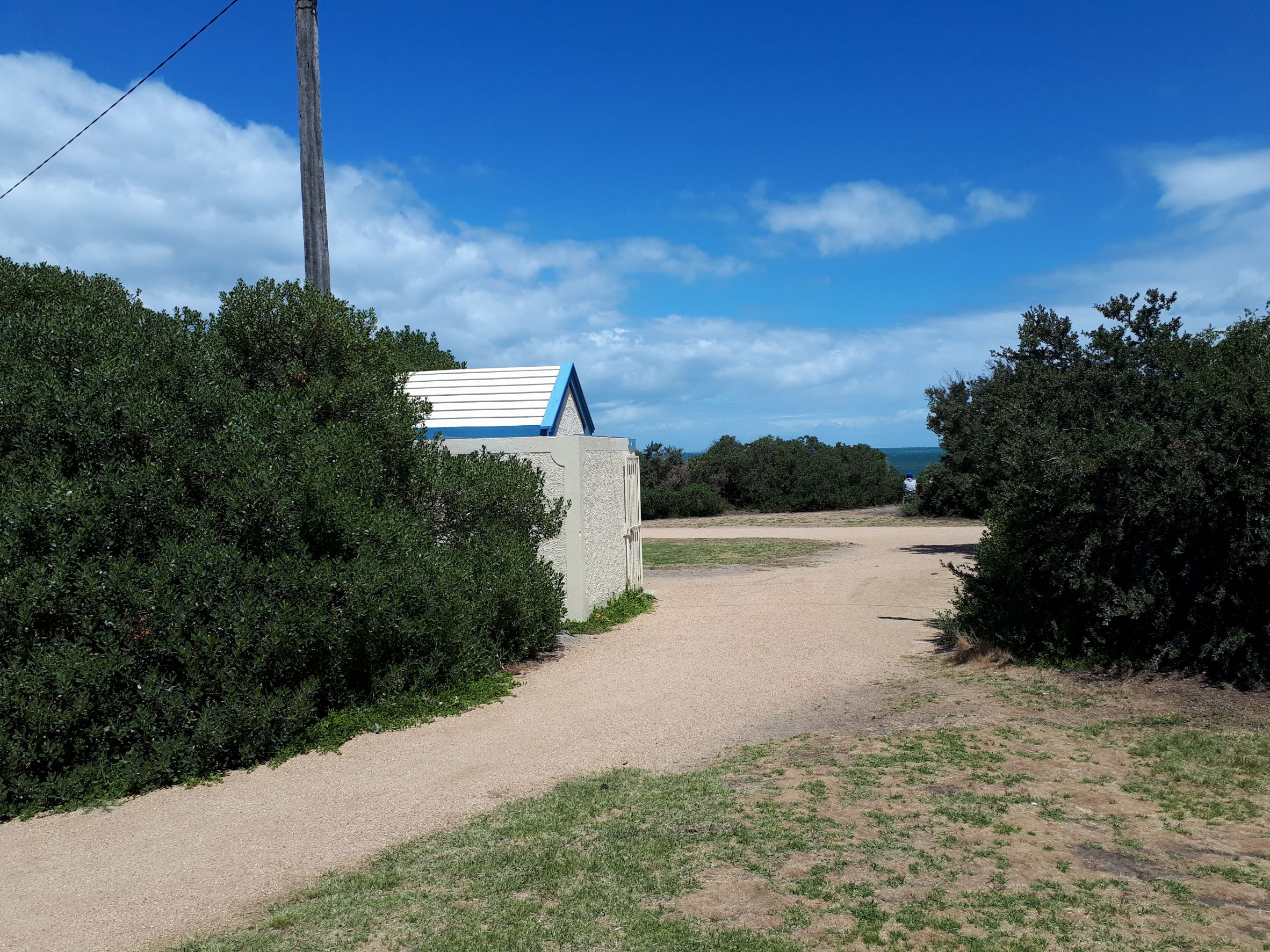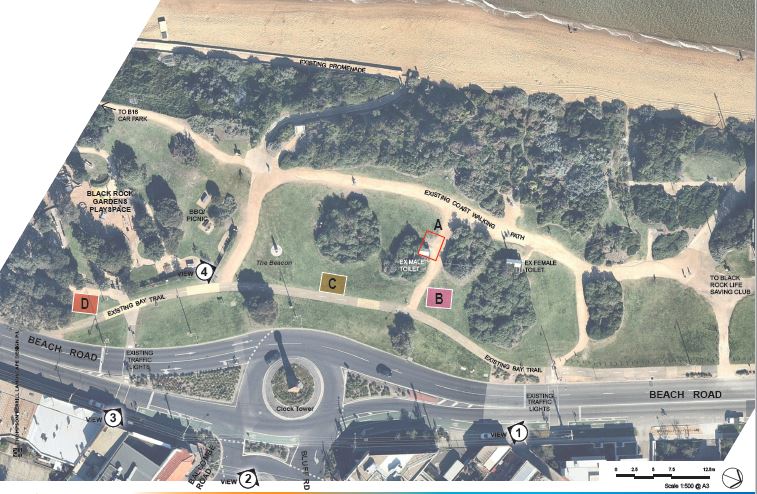Location decision
Thank you to everyone who contributed their feedback on the Black Rock Toilet Foreshore Public Toilet Independent Report and potential locations. Consultation is now closed.
We’ve listened to community feedback and we’re keeping the existing toilets on the Black Rock foreshore promenade where they are. Community members provided valuable feedback on four different location options. There was strong feeling that although building new toilets in a different location could work, it was much preferred to retain the old toilets in their current location and condition.
To provide public toilet facilities for people with mobility issues, we are adding an accessible toilet into the new Black Rock Life Saving Club building. We are working with the Club on the exact location and design of the toilet, as we look forward to delivering this amazing new community facility in 2022/23.
Read the Community engagement summary report here.
Existing Black Rock foreshore public toilets will remain

Frequently asked questions
We’ve listened to community feedback and we’re keeping the existing toilets on the Black Rock foreshore promenade where they are. Community members provided valuable feedback on four different location options. There was strong feeling that although building new toilets in a different location could work, it was much preferred to retain the old toilets in their current location and condition.
To provide public toilet facilities for people with mobility issues, we are adding an accessible toilet into the new Black Rock Life Saving Club building. We are working with the Club on the exact location and design of the toilet, as we look forward to delivering this amazing new community facility in 2022/23.
Extensive consultation was undertaken as part of the Black Rock Masterplan in 2016. Re-location and re-building of the toilet was part of that consultation. A number of locations were considered and ruled out because of community feedback.
There was also further information provided during the Black Rock Streetscape consultation in 2019 that including images, on site signage and a drop-in session.
Many factors need to be taken into account including: Crime Prevention Though Environmental Design (CPTED); local sightlines; below ground services and infrastructure; cultural heritage and proximity to local amenities (picnic area, playground, shared path, coastal trail and beach access).
An independent report was commissioned to determine the best location for the toilet as part of the masterplanning process and a review of this initial report was recently undertaken after feedback on the initial proposed location was received in October 2020.
We paused the project to consider the community feedback, reconsidered the location and now put forward this new proposal for community comment.
We have undertaken significant community engagement and commissioned two independent reports. A contractor was engaged to build the toilet and then construction was delayed for further consultation. Through our survey and other feedback, we now have a thorough understanding of what is important to the community, as well as technical requirements. We have balanced community feedback with selecting a site that has good sightlines to the playground, is accessible and has minimal visual impact from the road and Bay Trail. The final location has been selected as it best meets the communities stated preferences and requirements. No further consultation will be undertaken.
The existing facilities do not meet Disability Discrimination Act (DDA) requirements and it would not be cost-effective to retro-fit them. The existing toilets’ hidden location does not promote safety or meet Crime Prevention Through Environmental Design CPTED* guidelines. Bayside City Council is committed to best practice and wants to make sure the design and location of public facilities meet current standards.
Given the age of the pipes and the distance from the existing toilet, we will need to use new, modern pipes and install a pump to service the new toilet. The sewer has been confirmed as not meeting current standards and cannot be used. There will be additional redesign costs for the hydraulics (sewer and water), survey and environmental mitigation costs to protect vegetation.
[PG1]Might need to expand on this phrase
There was a strong feedback that a public toilet is needed at the Black Rock Life Saving Club for beach users, as well as public toilets closer to the playground and Bay Trail. Therefore we will be proceeding with toilets in both locations as forecast in the Black Rock Masterplan The Black Rock Masterplan was developed through community consultation in 2016 and was adopted by Council in May 2016.
The current design is the seventh generation of the standard Bayside public toilet and will be similar to the toilet on the foreshore at Sandringham, opposite Southey Street. The design includes one all abilities unisex cubicle, one ambulant unisex cubicle and a small cleaner’s room (some sites may have two ambulant unisex cubicles). The bright entry door colors are chosen to provide a contrast for people who are vision impaired. The design is bright, modern and attractive with good levels of natural light and ventilation. The design uses some recycled cladding, energy efficient solar lighting (where possible), and is cost effective to build, clean and maintain.

Permits were issued for the original location near Beach Road, and we will need to apply for new permits for the final location. The foreshore is Crown Land and we require a permit from the Department of Environment, Water, Land and Planning (DEWLP) and Marine and Coastal Act (MaCa) consent for the building footprint and visual sightlines. The foreshore area was also used by three traditional owner groups (the Boon Wurrung, Bunarong and Wurundjeri) and we need to obtain a Cultural Heritage permit to ensure the new toilet location does not contain any important indigenous relics or is on sacred land. We will also require new engineering design drawings for the selected location and consult with an arborist to ensure our native vegetation is protected. All new buildings also require a Planning Permit. The permit process usually takes several months so we envisage construction will start later in 2021. Please ‘Subscribe’ to this page by clicking on the blue button in the header to receive updates on this project.
Crime Prevention Through Environmental Design or CPTED is an approach to crime prevention that takes into account the relationship between the physical environment and the users of that environment. We all recognise when the space we are in sends us a message about safety, "this is a safe place" or danger, "this is an unsafe place". The theory behind CPTED is that the design of a physical environment can produce behavioural effects that will reduce both the incidence and fear of crime. These behavioural effects can be accomplished by reducing the susceptibility of the environment to support criminal behaviour. (Victoria Police, June 2015)
There are three basic strategies in CPTED:
Natural Surveillance
Natural surveillance is a design concept that aims to keep potential offenders and
intruders under observation through the creation of environments where there is
sufficient opportunity for people engaged in their normal behaviour to observe the
space around them. The underlying principle is that a person is less likely to commit
a crime if they think someone will see them do it.
Natural access control
The design concept of access control is directed primarily at decreasing criminal
accessibility. Natural access control restricts criminal intrusion, in particular into
areas where they will not be easily observed. The goal with this principle is not
necessarily to keep intruders out but to direct the flow of other people through the
area to decrease the opportunity for crime.
Territorial reinforcement
Territorial reinforcement is a design concept that clearly delineates private space from semipublic and public spaces and also creates a sense of ownership. When there is a sense of ownership within a space, strangers and intruders stand out and are more easily identified.
Project history
Following feedback received from the community on the proposed location for a new public toilet at Black Rock foreshore, we paused the project and reviewed the decision.
We commissioned an independent report to explore alternative locations. Read the Black Rock Foreshore Public Toilet Independent Report.
In selecting a suitable location for a new public toilet in this location, the following important factors need to be considered:
- close to public amenities (picnic area, playground, shared path, coastal trail and beach)
- highly visible for safety (CPTED)* and accessibility
- has access to underground infrastructure
- is sympathetic to environmental and cultural heritage concerns
- uses an existing path to aid access for people with mobility issues or parents with prams
- does not obstruct views to the bay.
The independent report recommends Option B and community was sough on this location and the other options in the report, with consultation closing on 23 December 2020
For more information about the new Black Rock Life Saving Club (BRLSC), please visit the BRLSC project page on our website.
Engagement plan overview
Read our plan about how we will engage with you during this process
Location options for the new toilet at Black Rock foreshore.

Click on the flashing coloured toilet icons to read a summary of information about each site. You can read detailed information about each option in the independent consultant's report.
More information
If you have any questions about the delivery of this project, please use the ‘Ask a Question’ option below on this page and your feedback will be passed on to the project working group.
We will provide updates on this project at key milestones. Please ‘Subscribe’ to this page by clicking on the blue button in the header to receive updates on this project.
Ask a question
If you would like to ask a question or need more information on the project, you can submit a question below. Please allow up to two business days for a response.
You can also search and review previous questions and answers.
This space is not for the provision of feedback or express your opinion. Any irrelevant, offensive or abusive statements may be removed to provide easy access to information by all.
To ask a question you must create an account or log in.
These are the people that are listening and responding to your questions.
Cliff Baxter
Open Space Projects Officer
{{question.description}}



